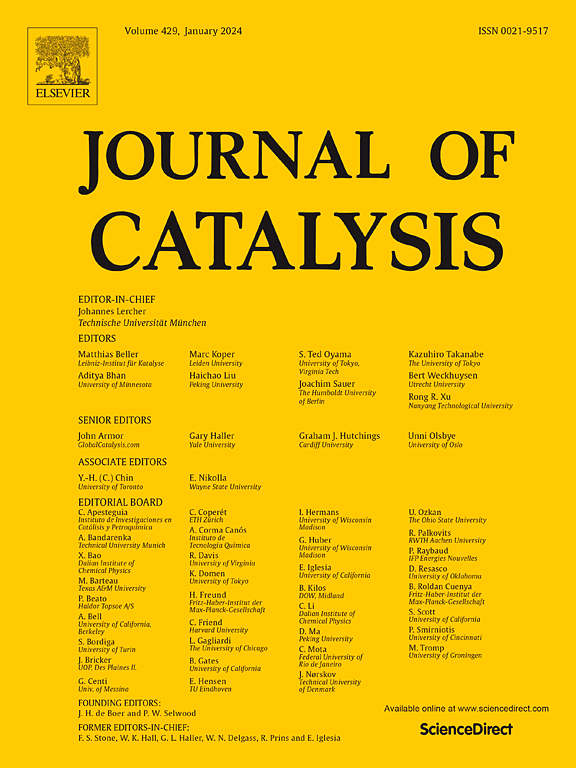Mo2C纳米片表面吸附*NH中间体通过N-N耦合自促进NO电化学还原
IF 6.5
1区 化学
Q2 CHEMISTRY, PHYSICAL
引用次数: 0
摘要
电化学还原NO (NORR)制氨因其在电催化脱硝和合成氨方面的潜力而受到广泛关注。过渡金属碳化物(tmc)因其对NO活化的高反应性,已成为NORR电催化剂的有希望的候选者。然而,它们在析氢反应(HER)中的特殊催化性能可能会阻碍NH3生产的法拉第效率。有趣的是,最近的实验研究表明,在典型的HER操作条件下,NORR几乎完全抑制了Mo2C纳米片上的HER,但潜在的机制尚不清楚。本文以实验报道的Mo2C为原型,利用最先进的大正则密度泛函理论计算,揭示了NORR在tmc上的原子级反应机理。我们的研究结果表明,在−0.3 V ~ 0 V vs. RHE电位范围内,Mo2C表面被一层化学吸附的*NH中间体氮化,导致表面中毒。而这些被吸附的表面*NH中间体可以通过N-N耦合机制有效吸附NO分子,使其电化学还原为NH3,反应动力学快,热力学好,表现出自促进的催化机制。重要的是,这些*NH中间体通过与进入的质子(或邻近的*NH种)的强静电排斥显著抑制HER,导致Heyrovsky反应和Tafel反应的势垒都超过2 eV。我们的计算结果对*NH中间体在促进NH3生成和抑制H2生成中的决定性作用提供了重要的见解,从而为合理设计基于tmc的NORR电催化剂提供了有价值的指导。本文章由计算机程序翻译,如有差异,请以英文原文为准。


Self-Promoting NO electrochemical reduction via N-N coupling by Surface-Adsorbed *NH intermediates on Mo2C nanosheets
Electrochemical reduction of NO (NORR) to ammonia has gained significant attention due to its potential in both electrocatalytic denitrification and ammonia synthesis. Transition-metal carbides (TMCs), with their high reactivity toward NO activation, have emerged as promising candidates for NORR electrocatalysts. However, their exceptional catalytic performance in the hydrogen evolution reaction (HER)—a major competing process—may hinder the Faradaic efficiency of NH3 production. Interestingly, recent experimental studies have shown that NORR almost completely suppresses HER on Mo2C nanosheets under typical HER operating conditions, but the underlying mechanism remains unclear. Here, using state-of-the-art grand canonical density functional theory calculations, we reveal the atomic-level reaction mechanism of NORR on TMCs by taking experimentally reported Mo2C as a prototype. Our findings show that within the potential range of −0.3 V to 0 V vs. RHE, the Mo2C surface becomes nitrogenated by a monolayer of chemisorbed *NH intermediates, leading to poisoning of the surface. However, these adsorbed surface *NH intermediates can effectively adsorb NO molecules through an N-N coupling mechanism, facilitating their electrochemical reduction to NH3 with fast reaction kinetics and favorable thermodynamics, thereby showing a self-promoting catalytic mechanism. Importantly, these *NH intermediates significantly suppress HER through strong electrostatic repulsion with incoming protons (or adjacent *NH species), leading to barriers exceeding 2 eV for both Heyrovsky and Tafel reactions. Our calculations provide crucial insights into the decisive role of *NH intermediates in promoting NH3 production while suppressing H2 generation, thus providing valuable guidance for the rational design of TMC-based NORR electrocatalysts.
求助全文
通过发布文献求助,成功后即可免费获取论文全文。
去求助
来源期刊

Journal of Catalysis
工程技术-工程:化工
CiteScore
12.30
自引率
5.50%
发文量
447
审稿时长
31 days
期刊介绍:
The Journal of Catalysis publishes scholarly articles on both heterogeneous and homogeneous catalysis, covering a wide range of chemical transformations. These include various types of catalysis, such as those mediated by photons, plasmons, and electrons. The focus of the studies is to understand the relationship between catalytic function and the underlying chemical properties of surfaces and metal complexes.
The articles in the journal offer innovative concepts and explore the synthesis and kinetics of inorganic solids and homogeneous complexes. Furthermore, they discuss spectroscopic techniques for characterizing catalysts, investigate the interaction of probes and reacting species with catalysts, and employ theoretical methods.
The research presented in the journal should have direct relevance to the field of catalytic processes, addressing either fundamental aspects or applications of catalysis.
 求助内容:
求助内容: 应助结果提醒方式:
应助结果提醒方式:


